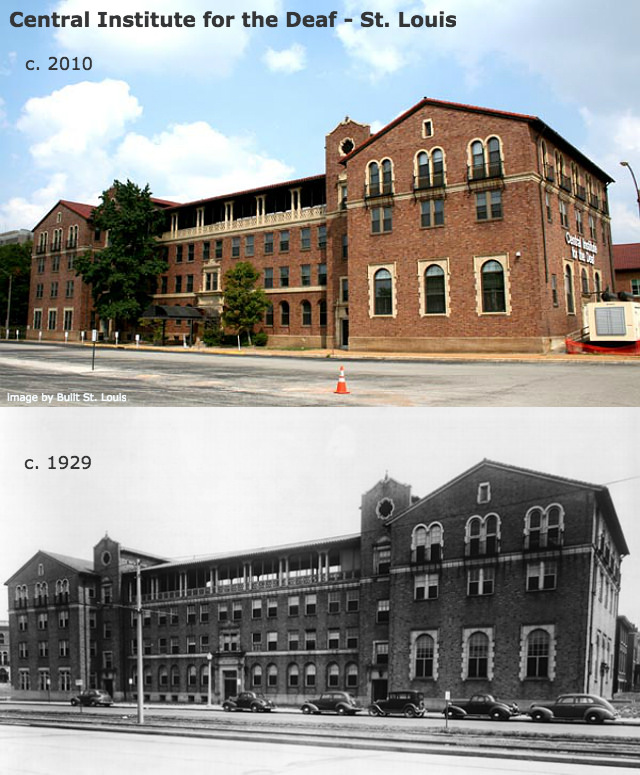
A day after a local media outlet confirmed the nextSTL story that the historic 1924 Shriners Hospital building would avoid the wrecking ball, nextSTL has learned that Washington University is planning to convert Shriners into a student housing campus.
The project would replace the existing Olin Residence Hall. Housing medical and graduate students in the School of Medicine, and other related disciplines located on the medical campus. That building houses approximately 200 students. Sources tell nextSTL that it will likely be repurposed, but could be demolished.
Olin was built in 1959 and has a total of 165 apartment units. The 10-story building at 4550 Scott Avenue and will most likely be converted to another use. The university is also exploring the conversion of the adjacent historic Central Institute for the Deaf building to student housing.
 {Olin Residence Hall – Washington University School of Medicine}
{Olin Residence Hall – Washington University School of Medicine}
Washington University purchased the former Shriners hospital at the corner of Clayton and Euclid Avenues shortly after Shriners left for a new facility in Frontenac, Missouri in the early 1960s. The building has served as office and classroom space since. A construction timeline has not been made public and final project details remain in planning.
The Shriners building will require substantial rehab but has also been updated in recent years to house computer servers and other information technology. The CID building is reportedly in a much more deteriorated condition and its suitability as student housing is still being considered.
The conversion of Shriners and CID would give the sprawling medical center a residential campus at its southern edge, just across Interstate 64 from the Forest Park Southeast neighborhood in which the university has invested heavily.

Olin Residence Hall is more or less a traditional dormitory. The average room consists of a wash basin and medicine cabinet with common bathroom facilities on each floor. The student lounge and rooftop deck have been kept up to date through multiple renovations.
An Olin resident spells it out on the school’s residential information webpage: “(K)eep in mind that you will be living in a dorm. This means living in a single with no common room plus shared kitchens and bathrooms. If anything I just described absolutely horrifies you, you will not be happy living here”. While perhaps not horrifying, this living arrangement if far from current expectations.
In early 2008, a new “Community Unit Plan” (CUP) was introduced at the St. Louis City Board of Aldermen displaying nearly a dozen buildings considered for demolition across the Central West End medical campus, home to Barnes-Jewish Hospital, the Washington University Medical School, St. Louis Children’s Hospital, St. Louis College of Pharmacy, and other institutions. Shriners and the oldest portion of the CID complex were labeled for future demolition.
 {Shriners Hospital building – completed 1924}
{Shriners Hospital building – completed 1924}

The 2008 CUP was an update to a more than three decades old development plan. The plan provides a framework for building permits, variances, certificates of occupancy, street vacations, and sign approvals. Buildings may be erected within the CUP area up to 30 stories, with a height limit of the Park East Tower (330ft) several blocks to the north.
Central Institute for the Deaf
Architect: William B. Ittner
Date: 1916; 1929
Central Institute for the Deaf: 909 S. Taylor. Dr. Max Aaron Goldstein founded the Central Inststitue for the Deaf (CID) in 1914 and the first building opened in 1916 at the current location; Architect William B. Ittner expanded the building in 1929 to complement the neighboring Shriner’s Hospital. Ittner maintained the Renaissance Revival style and added extensive laboratories, classrooms, and other facilities. The CID was initially envisioned as an institute to teach deaf children to speak and train teachers to deal with the special needs of the hearing impaired. In 1931, the CID Teachers Training College became the first deaf teachers college to be affiliated with a university when it created a partnership with Washington University. By 1947 the Institute offered graduate programs in deaf education, communication science, and the new field of audiology, which CID pioneered. In 1958, researchers and teachers implemented a parent-infant program that became a model for deaf education world wide. In 2000 the CID completed a new campus, which is a major addition adjoining the Ittner building to the east. The CID building was listed in the National Register in 2004. The building is threatened by the same plan that is entertaining the idea of demolishing the Shriners Hospital for a future expansion of the Washington Univeristy Medical Center.
Shriners Hospital
Architect: William B. Ittner
Date: 1922
Shriners Hospital: 700 S. Euclid. In 1921 the Shriners organization passed a proposal to create a network of free hospitals across the country to treat birth defects and crippled children. Their first hospital opened in 1922 in Shreveport, Louisiana. By the end of the 1920’s 13 more hospitals had been built around the United States. The St. Louis facility, one of the first, was designed by renowned St. Louis Architect William B. Ittner. Construction of the Renaissance Revival building began in 1922 and the hospital opened in 1924. The building currently houses offices, though some interior spaces once used for hospital purposes pose a challenge for adaptive re-use. The building is threatened by a Community Unit Plan (approved) for the Washington University Medical Center which proposes, among other things, the possible demolition of several architecturally and historically significant buildings to make room for future expansion.

